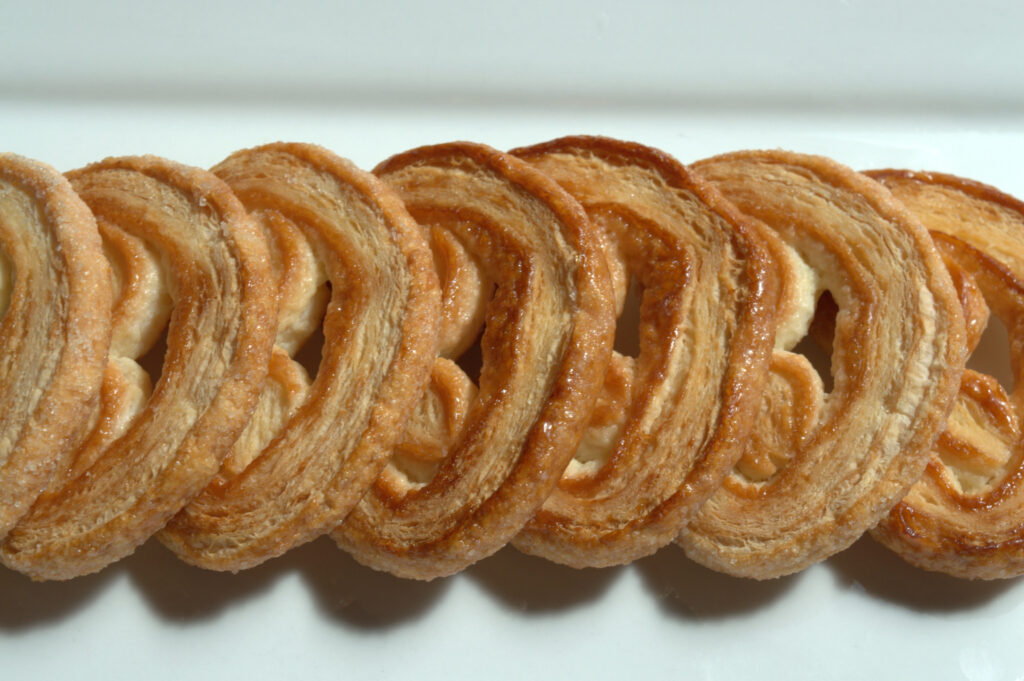Are you ready to explore the sweet side of Buenos Aires and dive into its rich bakery culture? ExpatPathways invites you to discover “The Typical Facturas and Croissants of Buenos Aires Bakeries,” a guide that uncovers the delicious secrets behind the city’s beloved pastries.
Whether you’re a digital nomad seeking the perfect breakfast companion or a traveler eager to taste local flavors, our detailed exploration of Buenos Aires’ bakeries will guide you through a mouth-watering journey of flaky, sweet, and savory delights.
From the iconic medialunas to the indulgent vigilantes, learn which bakeries serve up the best of these traditional treats and how they’ve become a staple in every porteño’s diet.
The Typical Facturas and Croissants of Buenos Aires Bakeries
1. Medialuna
At the heart of Buenos Aires’ pastry culture lies the beloved “medialuna,” an Argentine twist on the traditional croissant, cherished across the city for its sweet, fluffy texture and shiny, syrup-glazed surface.
Medialunas are smaller and denser than their French cousins, with a more compact dough that lacks the flaky layers typical of croissants. These pastries are a staple in local diets, enjoyed commonly at breakfast with café con leche, making them a central part of Buenos Aires’ morning ritual.
Varieties of medialunas
Bakeries throughout the city vie to produce the most delicious versions, offering them in two primary types: “medialuna de grasa” and “medialuna de manteca.” The former is made with animal fat, resulting in a thinner, less sweet, and slightly salty pastry, while the latter is richer, made with butter and often generously topped with a sticky sugar glaze.
In addition to these classic versions, there are also “medialunas rellenas,” which are an indulgent take on the buttery medialunas, stuffed with either creamy custard or sweet dulce de leche.
These filled variants cater to those with a sweeter tooth, offering a decadent twist on the traditional recipe. The making of medialunas is a labor of love that involves time-consuming preparation to achieve the perfect rise and texture, making each bite a reward in itself.

2. Vigilante
The vigilante is an elongated pastry, akin to a baton with a slight bulge in the middle, made from puff pastry. While it can be filled with quince jam (membrillo) or custard (crema pastelera), it is most commonly enjoyed plain but sweetened with a touch of sugar and syrup.
Smaller and lighter than a medialuna, the vigilante offers a more modest option for those seeking a lighter breakfast pastry that still delivers on taste.
3. Sacramento
The sacramento, often confused with the vigilante due to its elongated shape, stands out as it traditionally lacks any toppings.

This pastry can also be filled with quince jam or custard, although many prefer it unfilled, slicing it open to stuff with cheese and ham for a savory twist.
Unlike the classic medialuna, sacramentos do not have twisted ends, giving them a more streamlined appearance.
4. Tortita negra
Tortita negra, directly translating to “black cake,” features a somewhat tough, round, risen dough topped liberally with brown sugar, giving it a distinctive sweetness.
Some bakeries in Buenos Aires have taken to filling these with dulce de leche, adding a creamy texture and a burst of flavor that makes the extra calories well worth it.
5. Cañoncito
On the sweeter side, cañoncitos are a delight for those with a sweet tooth. These small to medium-sized pastries are made from flaky phyllo dough and are generously filled with dulce de leche, akin to an Argentine caramel.
They are often dusted with powdered sugar and praised for their longevity, maintaining quality and flavor for up to three days post-bake.
While dulce de leche remains a popular filling, some variations include custard-filled cañoncitos, offering an alternative for those looking to try something different.
6. Palmeras
Palmeras, also known affectionately as “palmeritas,” are heart-shaped delights made from puff pastry. Their unique shape not only makes them visually appealing but also practical, as they can be easily split into two halves, ideal for sharing or saving one half for later.
Depending on where you purchase them, palmeras can vary greatly in size and crispness, with some bakeries offering a crunchier texture than others.

7. Libritos
Moving on to libritos, these are crafted from phyllo dough, similar to cañoncitos, yet stand out due to their “small book” shape.
This design resembles the pages of a book, thanks to the layered fat and flour dough. Not all Argentine pastries are sweet, and libritos exemplify this with their savory options.
Typically made with butter (though lard versions exist), these pastries are sugar-free and often paired with ham, cheese, or even jams and butter for a hearty breakfast.
A similar variant is the “cuernito,” sharing the same recipe and ingredients as libritos but fashioned into a three-pointed horn shape, offering another savory choice for pastry lovers.
8. Berlinesas
Berlinesas, known locally as bolas de fraile, trace their roots back to central Europe. These doughy delights are fried and typically filled with dulce de leche or crema pastelera, and occasionally dipped in dark chocolate.
Similarly, the Argentine churro, an adaptation of the Portuguese classic, is deep-fried and rolled in sugar, often filled with dulce de leche or pastry cream, and sometimes draped in dark chocolate. These are particularly recommended alongside hot chocolate for a truly indulgent treat.
Not to be overlooked, donuts, which belong to the same family as berlinesas, share similar ingredients but are distinguished by their ring shape and variety of fillings and toppings, including dulce de leche, chocolate, and strawberry glazes.
9. Pan de leche
The pan de leche is a dough made with butter dough and eggs. Pastry cream is usually placed on its surface, and it is noted for its sponginess and tenderness.
It is a must for any breakfast or snack, especially accompanying a typical Argentine mate.
10. Lengüitas
Lenguitas are crafted with a dough similar to that used for sacramentos and vigilantes but are distinguished by their toppings—typically a generous layer of crema pastelera (custard) or dulce de membrillo (quince jam), or a combination of both.
These pastries are moderately sized, allowing for an indulgent taste of classic Argentine fillings without being overly heavy.
11. Pastelitos
Pastelitos, on the other hand, hold a special place in Argentine and Paraguayan cuisine, known locally as “pastelitos criollos” and in Uruguay as “pasteles dulces.”
These pastries are made with a flaky, crispy dough and can be baked or fried—the latter being dipped in boiling oil or lard and then sprinkled with sugar. In Argentina, they are often decorated with small sweets known as “granas” or dusted with powdered sugar.
Historically linked to the celebrations of May 25, 1810, marking Argentina’s first national government, pastelitos carry historical significance, with traditional vendors historically heralding them with cries of “¡pastelitos calientes que queman los dientes!” (hot pastries that burn the teeth!).
Commonly filled with dulce de membrillo and fashioned into a wrapped handkerchief shape before being drenched in syrup, some variations are filled with sweet potato jam, making them a revered treat during national celebrations and everyday life alike.
12. Torta frita
Delving deeper into the traditional pastries of Buenos Aires, we encounter “torta frita” and the renowned “croissant,” each bringing its own unique history and flavor to the city’s culinary scene. Torta frita is a beloved snack throughout Latin America, particularly noted for its simple yet satisfying nature.
These round, flat cakes are reminiscent of doughnuts in texture and taste but are made from a bread-like dough that may include yeast, eggs, and other ingredients. After fermenting, the dough is rolled out and fried in beef fat or neutral vegetable oil, making for a quick and delightful treat.
13. Croissant
The croissant, although commonly associated with French bakeries, traces its origins back to Austria. Larger than the local medialunas, with straight tips and a crispier, airier texture, croissants in Buenos Aires have carved out a niche of their own.
The preparation of a croissant is an art form involving few ingredients—yeast, flour, and butter or margarine—but requires many hours of kneading, rising, and cooling to achieve its distinctive flaky layers and light texture that set it apart from its Argentine counterparts.
Buenos Aires cafés often serve croissants with a variety of fillings and toppings, ranging from sweet options like chocolate and pistachio to savory selections like ham and cheese, avocado, or peanut, making them a popular choice for breakfast or a snack.

Last Considerations
Are you prepared to indulge in the exquisite facturas of Buenos Aires, each a testament to the city’s rich culinary tradition? From specialized bakeries to any local cafeteria and bar across Buenos Aires, these delightful pastries are readily available for you to enjoy.
ExpatPathways reminds you that the city’s bakers continue to innovate, offering “premium” sourdough versions and gluten-free alternatives to cater to all preferences and dietary needs.
Whether you’re a digital nomad looking for a taste of local culture, a traveler on a culinary quest, or an expat craving a sweet treat, Buenos Aires’ bakeries have something special just for you. Why not make it your mission to try each variety and find your favorite?
(Featured Image Source: rochkupp/flickr.com)


